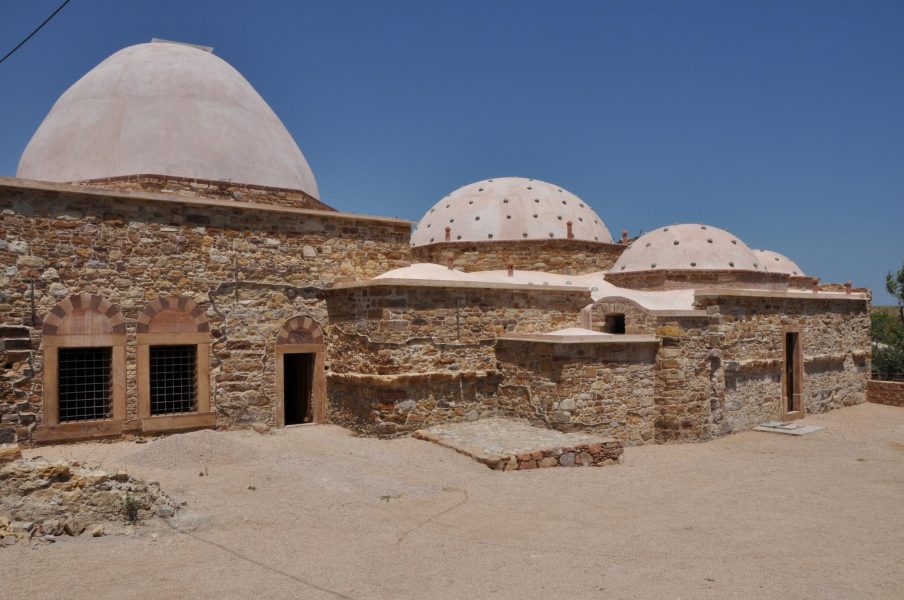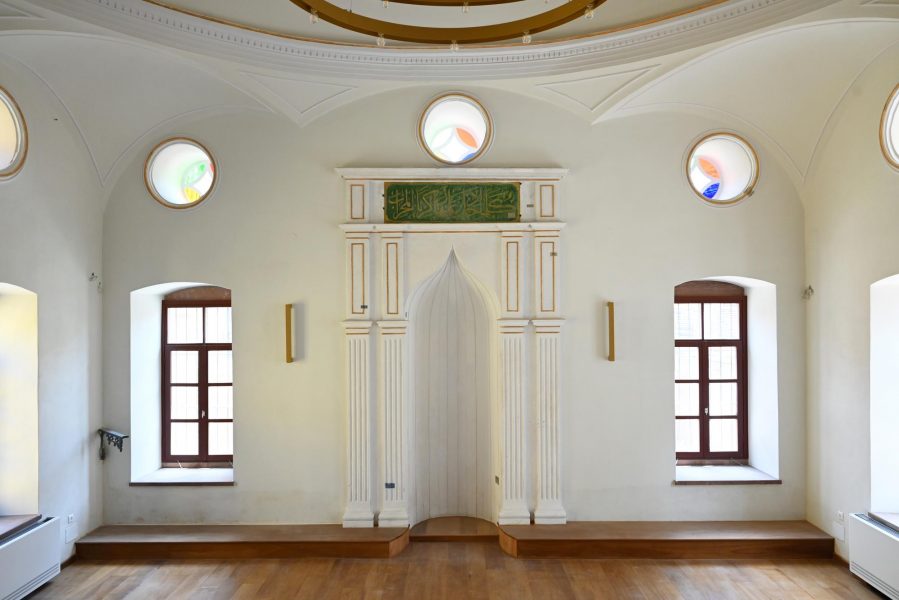2 FELLOWS PARTICIPATE IN THE GROUP EXHIBITION “My Past is a Foreign Country” curated by AKIS KOKKINOS
08.07.23 @ 18:30
DEO Projects in collaboration with Chios Ephorate of Antiquities presents My Past is a Foreign Country, a group large-scale exhibition presented between two historical monuments within Chios Castle, the Temenos* Hamidiye and the Ottoman Baths, both inherited by the Ottoman Empire. The exhibition invites twelve artists from Greece, Turkey, Lebanon, Iran, and Cyprus to reflect on the palimpsest histories of the island and examine borderland cultures, collective traumas, and forms of iasis**.
Eight of the twelve participating artists were commissioned to create new works for the exhibition drawing inspiration from the venues’ history, the island’s collective memory and the linkage between the Eastern Mediterranean peoples’ histories and the global community. Through eight in-situ new works, four existing works and a plurality of mediums –including sculptures, paintings, textiles, ceramics, installations, and photography– the invited artists touch upon the conflicted historical imaginations and the memory that they construct. Resisting geo-political anxieties, the artists form cross-cultural intimacies and highlight collective solidarity and kinship while strengthening forms of representation and inclusivity within the diverse social fabric of Chios.
The exhibition pays tribute to the monuments’ genealogy and explores historical incisions and connections with current socio-political events in the neighbouring regions of south-eastern Mediterranean and the Middle East. Temenos Hamidiye (or Mbairakli mosque) was rebuilt to honour the victims of the Chios earthquake of 1881 and its devastating effects, which heavily impacted the whole island, including the two exhibition venues. Inevitably the recent destructive earthquakes in Turkey and Syria create associations with the island’s past, by drawing connections between these natural disasters and their socio-political aftermaths. The exhibition highlights the enduring impact of such events on vulnerable communities across time and borders and offers a space for grief, mourning and reflection on the human condition which unites us all with the past, with each other and with the here and now; while at the same time it sheds light to the resilience of the human kind and the powerful story telling of local communities which enhances the narrative of the global community. On the other side, The Baths served as a site of cultural and social exchange and a place of cleansing in the lives of Chios Castle’s inhabitants during the Ottoman Empire. In the 20th century, both venues, the Baths and the Temenos, were used as sanctuary for refugees from Asia Minor during the exchange of populations. Today, the activation of the Eastern Mediterranean pathways, led to refugees being temporarily hosted in the Castle’s entrance located in a walking distance from the venues before settling in the hot spot facilities outside the city of Chios.
The exhibition borrows its title from the opening phrase: the past is a foreign country; they do things differently there, in the novel the Go-between by L.P. Hartley, published in 1953. The phrase has extensively been used in other publications, screenings, films, talks, music albums including Zeba Talkhani’s memoir on growing up in Saudi Arabia and her quest for freedom through education in India, Germany and England. The multiplicities of the title’s origin, and the specificity into the Chios context, provide new strands of meaning into how we deal with the past, the overlooked, and the forgotten.
*Temenos: From Ancient Greek τέμενος (témenos). A piece of ground surrounding or adjacent to a temple; a sacred enclosure or precinct.
Temenos in Greek is mostly used as a reference to a Mosque.
**Iasis: Originally from Ancient Greek ἴασις (íasis). A Latin word-forming element meaning “process” or “morbid condition”. Ancient Greek word for Healing.
My Past is a Foreign Country
Group exhibition
8 July – 28 August
Chios Castle, Chios (Chora), 82 100
Exhibition Venues: Temenos Hamidiye & Ottoman Baths
Participating artists:
Hera Büyüktaşcıyan (TR), Stelios Faitakis (GR), Nikomachi Karakostanoglou (GR), Avish Khebrehzadeh (IR/USA), Maro Michalakakos (GR), Petros Moris (GR), Dala Nasser (LB), Yorgos Petrou (CY), Aykan Safoğlu (TR/DE), Mounira al Solh (LB), Maria Tsagkari (GR), Abbas Zahedi (UK/IR)
Curated by Akis Kokkinos, Founder of DEO Projects.
Exhibition Venues’ Location: Temenos Hamidiye and Ottoman Baths, Chios Castle, Chios (Chora), 82 100, Greece
Opening hours
Ottoman Baths: daily 8:30 – 15:30 except for Tuesday
Temenos Hamidiye: daily 10:00 – 15:30 except for Tuesday
Free admission
Opening reception: 8 July, 18:30 – 21:00
Live performance on 8 July at 19:30 at the courtyard of the Ottoman Baths by DEO Commission Series artist, Saskia Calderón.
INFORMATION ABOUT THE EXHIBITION VENUES
Temenos Hamidiye or Mbairakli Mosque
The Hamidiye or Mbairakli Mosque was founded in 1892 as a tribute to the victims of the catastrophic earthquake of Chios in 1881. It is located in the centre of the Chios Castle and was built in the place of a Christian church. A Minaret used to stand at the west corner of the square building but unfortunately has not been restored. The current monument is a single-hall building, covered with a tile roof on the exterior, and a blind, timber-framed plastered dome on the interior. Inside the Mosque there is also a Mihrab indicating the direction of the Kaaba in Mecca towards which Muslims should face when praying. On the roof top there is the Crescent Moon symbolizing Islam. Above the entrance there is a marble Ottoman founding inscription. The Mosque has been declared a monument worthy of preservation and has been restored by the Ephorate of Antiquities of Chios in order to be used as a cultural space and to house cultural events. The DEO Projects exhibition is the first event to be hosted in the Mosque upon completion of restoration.
Ottoman Baths
The Ottoman Baths, the largest hammam in the Castle of Chios, are a living proof of the Ottoman occupation even though there are sources to testify to their existence even from the Byzantine Empire era. The great earthquake of 1881, however, caused a great damage in the largest part of the island including the Baths. At the left side of the venue there is the entrance, the welcoming area and the “changing rooms”. Next, the visitor faces the grand hall with the central dome, decorated with cornices and other elements emitting the glory of the Ottoman era. On the dome there are holes, through where the sun light comes in while there is a third room, where the water springs are to be found. Restoration brought to light about 800 coloured and decorated tiles. Since the completion of restoration, the Baths are open to the public as a monument.
DEO and its 2023 Summer Program have been generously supported by:
Major Donors: Stamos J. Fafalios, Theodore Fatsis & Maria Apodiacos, Yiannis Skoufalos & Maria Kalomenidou, Patron: Constantine & Christina Logothetis, Supporter: Irene Panagopoulos, Young Patrons: Tina Livanos, Constantin Pavleas and Eugenia Vandoros.
Complimentary support by Alex Haidas and Angelicoussis Foundation.
With the support of: OUTSET
Sponsors: THE FABULOUS GROUP
*Petros Moris and Maria Tsagkari are SNF ARTWORKS Fellows in visual arts. Akis Kokkinos is a curatorial SNF ARTWORKS Fellow.





